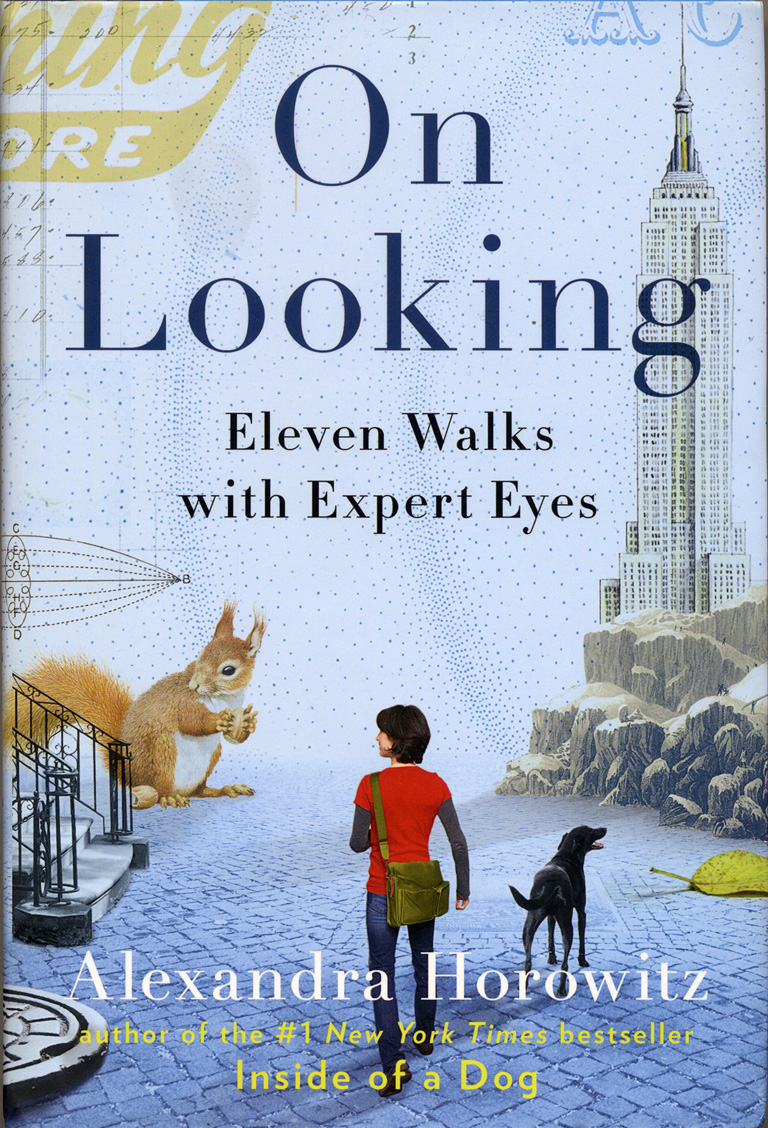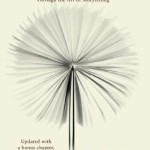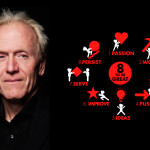“The result of these walks on my head is tangible: they refined what I can see.”
From the author of the giant #1 New York Times bestseller Inside of a Dog comes an equally smart, delightful, and startling exploration of how we perceive and discover our world.
Alexandra Horowitz’s brilliant On Looking: Eleven Walks with Expert Eyes shows us how to see the spectacle of the ordinary—to practice, as Sir Arthur Conan Doyle put it, “the observation of trifles.” On Looking is structured around a series of eleven walks the author takes, mostly in her Manhattan neighborhood, with experts on a diverse range of subjects, including an urban sociologist, the well-known artist Maira Kalman, a geologist, a physician, and a sound designer. She also walks with a child and a dog to see the world as they perceive it. What they see, how they see it, and why most of us do not see the same things reveal the startling power of human attention and the cognitive aspects of what it means to be an expert observer.
As the million-plus readers of Inside of a Dog have discovered, Alexandra Horowitz is charmingly adept at explaining the mysteries of human perception. Trained as a cognitive scientist, she discovers a feast of fascinating detail, all explained with her generous humor and self-deprecating tone. On Looking presents the same engaging combination, this time in service to understanding how human beings encounter their daily worlds and each other.
Page by page, Horowitz shows how much more there is to see—if only we would really look. On Looking is nutrition for the considered life, serving as a provocative response to our relentlessly virtual consciousness. So turn off the phone and other electronic devices and be in the real world—where strangers communicate by geometry as they walk toward one another, where sounds reveal shadows, where posture can display humility, and the underside of a leaf unveils a Lilliputian universe—where, indeed, there are worlds within worlds within worlds.
Alexandra Horowitz’s On Looking confirms her place as one of today’s most illuminating observers of our infinitely complex world. [From: Barnesandnoble.com]
“Part of seeing what is on an ordinary block is seeing that everything visible has a history. It arrived at the spot where you found it at some time, was crafted or whittled or forged at some time, filled a certain role or existed for a particular function. It was touched by someone (or no one), and touches someone (or no one) now.”
You are missing most of what is happening around you right now. You are missing what is happening in the distance and right in front of you. In reading these words, you are ignoring an unthinkably large amount of information that continues to bombard all of your senses. The hum of the fluorescent lights; the ambient noise in the room; the feeling of the chair against your legs or back; your tongue touching the roof of your mouth; the tension you are holding in your shoulders or jaw; the constant hum of traffic or a distant lawnmower; the blurred view of your own shoulders and torso in your peripheral vision; a chirp of a bug or whine of a kitchen appliance.
On Looking begins with inattention. It is not meant to help you focus on your reading of Tolstoy; it is not about how to multitask. Rather, it is about attending to the joys of the unattended, the perceived “ordinary.” Horowitz encourages us to rediscover the extraordinary things that we are missing in our ordinary activities. Even when engaged in the simplest of activities-taking a walk around the block-we pay so little attention to most of what is right before us that we are sleepwalkers in our own lives. So turn off the phone and portable electronics and get into the real world, where you’ll find there are worlds within worlds within worlds. [From: Goodreads.com]
“The other part of seeing what is on the block is appreciating how limited our own view is. We are limited by our sensory abilities, by our species membership, by our narrow attention—at least the last of which can be overcome.”
Alexandra Horowitz does more than open our eyes in On Looking: Eleven Walks with Expert Eyes. She opens our hearts and minds, too, gently awakening us to a world — in fact, many worlds — we’ve been missing.
Horowitz, a cognitive scientist and professor of psychology at Barnard College, has gone this route before. Her 2009 best seller, Inside of a Dog: What Dogs See, Smell and Know, took a scientific stroll into the perceptual world of dogs, investigating what it might actually be like to be a dog.
This time she has a leg up on the species in question — humans — and our attention-deficient modern lives.
“We see, but we do not see,” she writes. “We use our eyes, but our gaze is glancing, frivolously considering its object. We see the signs, but not their meanings. We are not blinded, but we have blinders.”
There are, naturally, a host of reasons for our behavior, particularly urban dwellers like Horowitz who must navigate the streets of New York City on a daily basis. Often we don’t see, because we choose not to, restricting our field of vision to the electronic device in front of us or wearily retracing our usual steps from point A to point B by rote.
Sacrificed in the mix, says Horowitz, is “the possibility of being surprised by what is hidden in plain sight.”
So the author, who proves to be a charming companion, takes the reader by the hand for a delightfully brisk and revealing set of walks with her experts: a geologist, a typographer, an illustrator, a naturalist, a wildlife researcher, an urban sociologist, a blind woman, a doctor, a sound designer and engineer, her toddler son, and her dog, Finn.
“Together,” she says, “we became investigators of the ordinary, considering the block — the street and everything on it — as a living being that could be observed.”
Not surprisingly, each of Horowitz’s experts brings a particular focus and set of sensitivities to the walks — most of which take place in the author’s Upper West Side Manhattan neighborhood. The geologist finds history and points to signs of life in the bedrock of the city; the sound designer tunes in to “wet” and “dry” spaces; the typographer reads the signs; the doctor diagnoses passersby, and Horowitz’s son brings an unedited appreciation for “muchness.” The pages hum and shine as a result, warmly reflecting the author’s genuine enthusiasm for her work and its revelations.
Horowitz discovers, not surprisingly, that she was, like most of us, missing too much of what was right in front of her and asks us to at least begin to take it all in anew: the animate and inanimate; the sights, sounds and smells; the nature and the pathologies of everyone and everything.
“There is no mandate,” she concludes, “only opportunity.” [From: Books.usatoday.com]
“What allowed me to see the bits that I would have otherwise missed was not the expertise of my walkers, per see; it was their simple interest in attending. I selected these walkers for their ability to boost my own selective attention. An expert can only indicate what she sees; it is up to your own head to tune your senses and your brain to see it. Once you catch that melody, and keep humming, you are forever changed.”
We think we see all the time. We think we observe. We also think we possibly know the world around us the way we are meant to. We see what we expect to most of the time. Maybe our mind conditions itself to show us only those things which we want to and the ones that we do not want to, well, they just get hidden. It could happen anywhere. In a familiar neighborhood or maybe in a place you have never been to before. Maybe it is all about perspective or maybe about security, however it exists in all of us. The way we see and perceive of our surroundings or rather what we do not see.
“On Looking: Eleven Walks with Expert Eyes” by Alexandra Horowitz is a book that maybe does not teach you how to look, but definitely provides some refreshing perspectives on the subject. The premise of the book is simple: Walking around the same path in a city with different people, almost eleven people or as she says twelve, and getting their point of view. The people ranged from her son to well-known illustrator Maira Kalman to a sound designer, bringing not only different perspectives but also making her and the readers think about our own perceptions. [From: Thehungryreader.wordpress.com]
Horowitz (Inside of a Dog) turns neighborhood walks into an exploration of how people interpret the world. Each walk pairs her with a different companion, each experience offering expertise in a wildly different arena, from the fractured geology of Horowitz’s native Manhattan to a city block’s surprisingly abundant insect life or how blind people experience the world. Some walks playfully dip into academic specialties, as when Dr. Bennett Lorber displays his Sherlock Holmes–like knack for diagnosing passersby, or when urban behaviorist Fred Kent shares his counter intuitive perspective as president of the Project for Public Spaces. Elsewhere, a sound engineer explains the “auditory restoration” phenomenon, in which the mind fills in unheard sounds, while a typographer examines fonts and lettering on signs and buildings, going so far as to distinguish between different forms of the letter “Q.” Even when Horowitz leaves her home turf to venture to Philadelphia and to Springfield, Mass., or consults such dubious “experts” as her dog, Finnegan, and toddler son, her writing remains insightful. The quirks in how each individual processes the same picture provide readers with their own eyes refreshed, ready to take a good look around them. [From: Publishersweekly.com]
Round and round the blocks of New York City, Horowitz (Psychology, Animal Behavior, and Canine Cognition/Barnard Coll.; Inside of a Dog: What Dogs See, Smell and Know, 2010) takes readers on multiple walks, showing us what we fail to spot when we don’t pay attention. Her young son sees green triangles, trucks and his own shadow, among other things. Others see the stone formed into buildings, the marks of thousands of insects and a rat preening its face. Horowitz combines her minute observations with history and science, bringing new connections to the sometimes-mundane sights and sounds of a city. Her horizons were expanded during her walk with artist Maira Kalman, who viewed a church as more than just a place for religion; “it was about music and company and freedom of allegiances.” Through the eyes of the artist, “objects and people on our route became possibilities for interaction, rather than decoration or obstruction, as the urban pedestrian might define them.” From the multitude of typefaces found in street signs, to the differences in sounds made by a shuttle bus or a city bus, to the animals that share the city streets and sewers, each walk enabled Horowitz to perceive the same environment in a fresh, new way. Simply by paying attention, the author’s senses were opened to experiences she would have otherwise completely missed. By reading her engaging stories, readers can learn to see their own environments, whether city or country, and open their minds to the exciting world that surrounds them. There is no right or wrong way to do this; one just must be open to the possibilities and be willing to try. An enjoyable closer look at what most people miss when walking through a city. [From: Kirkusreviews.com]
“Horowitz writes like a poet, thinks like a scientist, and ventures like an explorer. Her book will have you looking in a new way at the world around you, and make you glad you did.”
“These eleven exquisite, clever and and tenderly recounted small adventures remind me of something I learned back when I lived in India: the need to perceive “the scent behind the smell.” Alexandra Horowitz has attempted much the same thing with her eyes – much aided by the seeing of others – and has in consequence become increasingly successful in perceiving what one might call “the sight behind the scene.” Her resulting epiphanies are available to us all, if we take care to learn from her, in this lovely book, just how it is done.”
“Alexandra Horowitz’s new book is as wonderful as her first. Inside of a Dog helped us to imagine the worlds of our beagles, collies, greyhounds and mutts. On Looking teaches us that the world is just as rich, strange and charmed when seen through the eyes of our local artists, doctors, architects and toddlers. On Looking also teaches us that Alexandra Horowitz is a writer to watch.” [A Review from The Publisher]
“Do not sag with exhaustion. There is no mandate; only opportunity. Our culture fosters inattention; we are all creatures of that culture. But by making your way through this book—by merely picking it up, perhaps—you, reader, are in a new culture, one that values looking. The unbelievable strata of trifling, tremendous things to observe are there for the observing. Look!”
Now Watch Her Video:
Alexandra Horowitz Talks About On Looking: Eleven Walks with Expert Eyes
If you like this story, CLICK HERE to join the tribe of success-minded people just like you. You will love our weekly quick summaries of top stories, talks, books, movies, music and more with handy downloadable guides, cheat sheets, cliffs notes and quote books.
















